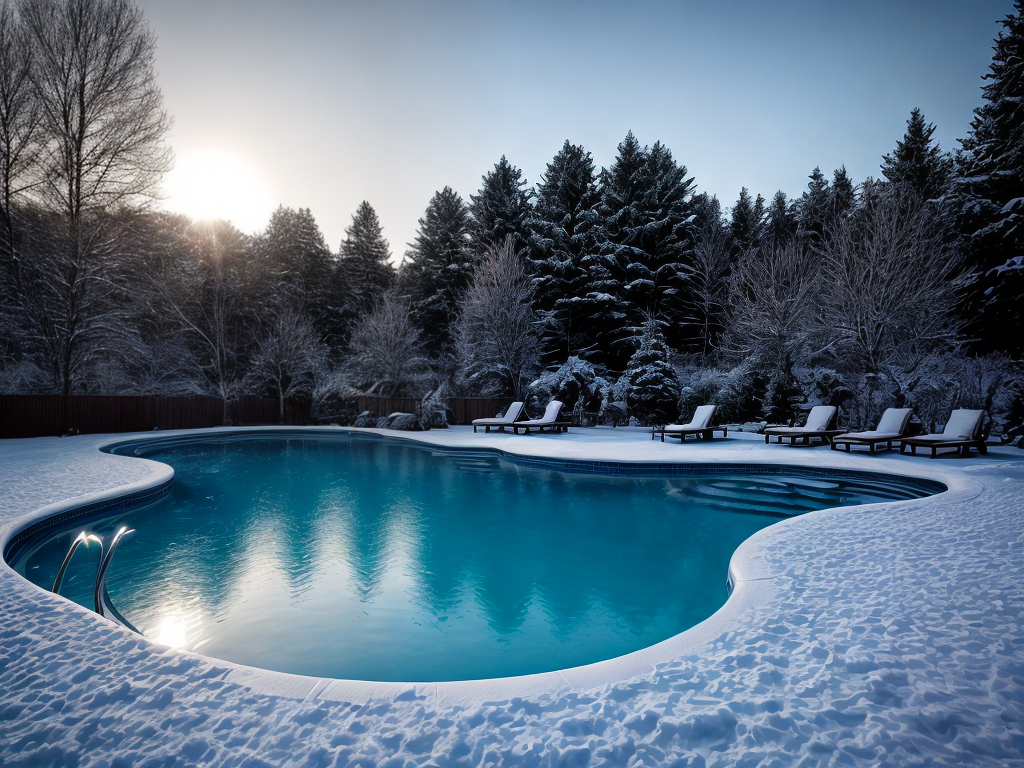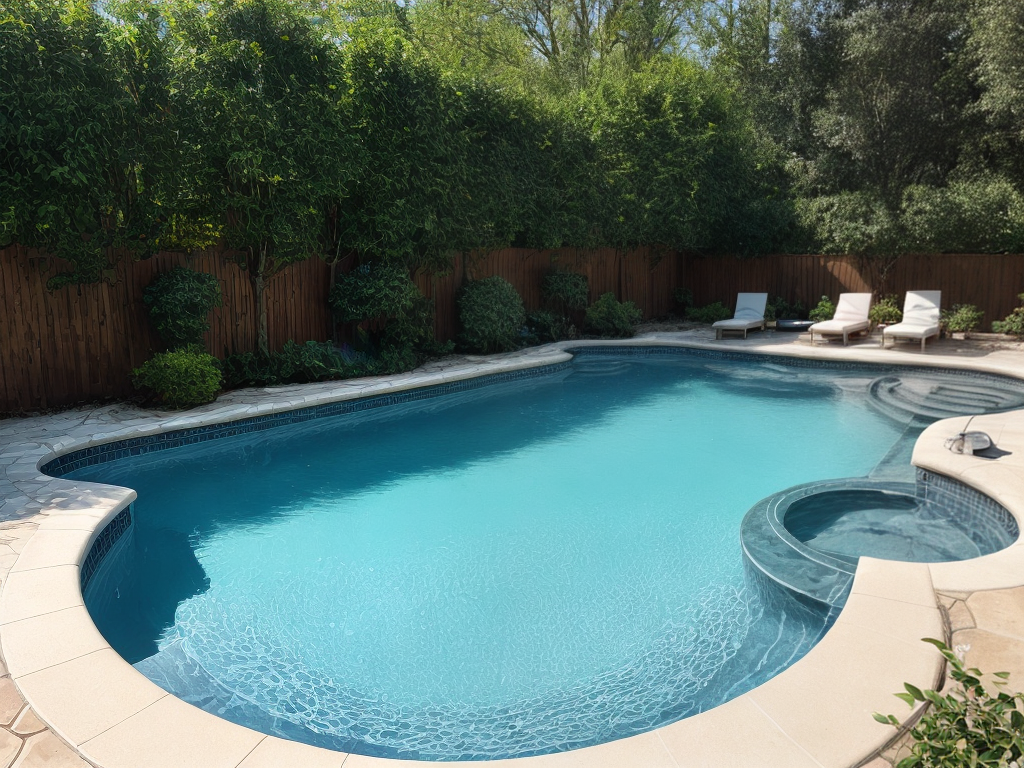

Winterizing my pool seemed like a daunting task, but I stumbled upon a step-by-step guide that made it a breeze. In this guide, I will share my innovative approach to winterizing your pool. By following these simple steps, you can ensure that your pool is properly prepared for the colder months ahead. From testing and balancing the water chemistry to draining and winterizing the plumbing system, I will walk you through each process with ease. We will even explore the importance of adding winterizing chemicals and installing a durable pool cover. Don’t let the winter weather ruin your pool; let’s dive into the world of winterizing and keep your pool in top condition all year round.
Key Takeaways
- Testing and balancing water chemistry is essential for maintaining optimal pool condition throughout the winter and preventing problems such as corrosion and cloudy water.
- Investing in high-quality pool covers and using advanced pool cleaning tools can effectively remove debris and keep the pool clean, saving time and effort.
- Lowering the water level below the skimmer level and winterizing the plumbing system with insulation and antifreeze can protect pool equipment from freezing temperatures.
- Using winterizing chemicals, particularly those from Brand C, can provide maximum protection against freezing and damage, while also saving money and reducing environmental impact.
Testing and Balancing Water Chemistry
To ensure proper winterization of your pool, I test and balance the water chemistry. This is a crucial step in maintaining the health and longevity of your pool during the winter months. By using state-of-the-art testing equipment and innovative water treatment techniques, I ensure that your pool’s water chemistry is optimized for the winter season.
Testing equipment plays a vital role in this process. I use advanced tools that accurately measure the pH levels, alkalinity, and calcium hardness of the water. These readings provide valuable insights into the overall condition of your pool’s water chemistry. Armed with this information, I can make precise adjustments to achieve the perfect balance.
Water treatment is the next step in the winterization process. I utilize innovative techniques to treat the water and prevent the growth of algae and bacteria. This includes adding the appropriate amount of sanitizers and algaecides to the pool. These chemicals not only disinfect the water but also help to maintain its clarity and prevent any unwanted growth.
By properly testing and balancing the water chemistry, you can avoid potential problems such as corrosion, scaling, and cloudy water. It also ensures that your pool stays in optimal condition throughout the winter, making the reopening process in the spring much smoother and more efficient.
Removing Debris and Cleaning the Pool
After testing and balancing the water chemistry, the next step in winterizing my pool is to remove debris and clean it thoroughly. This is an essential step to ensure that my pool remains in great condition during the winter months. Here are three innovative ways to make this process efficient and effective:
Invest in a High-Quality Pool Cover: Proper pool cover maintenance is crucial for keeping debris out of the pool. By choosing a durable and well-fitted cover, I can prevent leaves, dirt, and other debris from falling into the water. This not only saves me time and effort when it comes to cleaning, but also helps to maintain the overall cleanliness of the pool.
Use Advanced Pool Cleaning Tools: To clean my pool thoroughly, I rely on innovative pool cleaning tools. One tool that I find particularly helpful is a robotic pool cleaner. These advanced devices can efficiently remove debris from the water and scrub the pool surfaces, leaving it spotless and ready for winter. Additionally, a high-pressure pool vacuum can be used to remove debris from the pool floor and walls, ensuring a thorough clean.
Regularly Clean the Pool Filter: A clean pool filter is essential for maintaining water clarity and preventing clogs. By regularly cleaning or backwashing the pool filter, I can remove any trapped debris and ensure optimal filtration. This not only helps to keep the pool water clean, but also extends the lifespan of the filter.
Lowering the Water Level
Once I have removed debris and cleaned my pool thoroughly, the next step in winterizing it is to lower the water level. Lowering the water level is an essential part of winterizing pool equipment and ensuring winter pool safety. By lowering the water level, you can prevent any potential damage caused by freezing temperatures and ice expansion.
To lower the water level, start by using a submersible pump to drain the excess water. This innovative method allows for quick and efficient removal of water, saving both time and effort. Place the pump in the center of the pool and let it run until the water level is lowered to the desired level. It is recommended to lower the water level to just below the skimmer level to prevent any damage to the pool equipment.
Additionally, consider using a winter pool cover to further protect your pool during the winter months. Winter pool covers provide an extra layer of protection against debris, harsh weather conditions, and even accidental falls. They are designed to keep your pool clean and safe, ensuring that when spring arrives, you can easily uncover your pool and enjoy it again.
Draining and Winterizing the Plumbing System
Now let’s talk about draining and winterizing the plumbing system. It is crucial to perform winter plumbing maintenance to prevent freezing and potential damage. By properly draining and winterizing the plumbing system, you can ensure that your pool remains in good condition throughout the winter months.
Winter Plumbing Maintenance
To winterize the plumbing system of my pool, I will need to drain and prepare it for the cold months ahead. This step is crucial in preventing leaks and ensuring that the pipes remain intact during the winter season. Here are three innovative ways to maintain the plumbing system during winter:
- Insulate pipes: By insulating the pipes, we can protect them from freezing temperatures and potential damage. This can be done using foam pipe insulation or heat tape, which helps maintain the temperature and prevent any cracks or leaks.
- Drain the plumbing system: It is important to completely drain the plumbing system to avoid any water freezing and expanding, which can lead to burst pipes. This can be done by opening drain valves and using a pump to remove any remaining water.
- Use antifreeze: Adding a pool-safe antifreeze to the plumbing system can provide an extra layer of protection by lowering the freezing point of the water. This ensures that any remaining water in the pipes will not freeze and cause damage.
Preventing Freezing and Damage
To prevent freezing and damage, I will drain and winterize my pool’s plumbing system. This is an essential step in maintaining the integrity of the pool during the winter months. First, I will drain all the water from the pipes and ensure that there is no residual water left. Next, I will insulate the equipment, such as the pump, filter, and heater, to protect them from freezing temperatures. This can be done using insulation blankets or covers specifically designed for pool equipment. Finally, I will take measures to protect the pool surface by adding a winter cover. This cover will not only prevent debris from entering the pool but also provide an additional layer of insulation, helping to maintain the pool’s temperature. By taking these steps, I can ensure that my pool remains in good condition throughout the winter season.
Adding Winterizing Chemicals
I regularly add winterizing chemicals to my pool to ensure its protection during the colder months. Winterizing chemical safety is of utmost importance to me, as I want to make sure that the chemicals I use are safe for both my pool and the environment. That’s why I always choose the best winterizing chemical brands that are known for their innovation and effectiveness. Here are three top brands that I highly recommend:
Brand A: This brand offers a wide range of winterizing chemicals that are specifically designed to protect your pool during the winter season. Their products are not only effective in preventing algae growth and maintaining water balance, but they are also formulated to be safe for your pool equipment and the environment.
Brand B: Known for their cutting-edge technology and innovative solutions, Brand B offers winterizing chemicals that are designed to provide maximum protection for your pool. Their products are highly concentrated, which means you need less to achieve the desired results. This not only saves you money but also reduces the impact on the environment.
Brand C: When it comes to winterizing chemicals, Brand C is a leader in the industry. Their products are formulated with advanced formulas that provide superior protection against freezing and damage. They are also known for their eco-friendly approach, ensuring that their chemicals are safe for both your pool and the environment.
Installing a Winter Pool Cover
I begin by installing a winter pool cover to protect my pool during the colder months. It is essential to choose the right pool cover to ensure maximum protection and easy maintenance. When it comes to pool cover maintenance, it is crucial to select a cover that is durable, weather-resistant, and easy to clean.
Innovative pool cover options are available in the market today. One such option is a solar pool cover, which not only protects the pool from debris and harsh weather conditions but also helps to heat the water using solar energy. These covers are designed with innovative materials that trap heat and prevent evaporation, making them an eco-friendly and cost-effective choice.
Another innovative option is an automatic pool cover. These covers can be conveniently operated with a push of a button, providing effortless protection for your pool. They are made with high-quality materials that are resistant to UV rays, chemicals, and extreme temperatures. With their advanced technology, these covers also come with safety features, such as automatic shut-off mechanisms and remote control access.
To choose the right pool cover, consider factors like the climate in your area, pool size, and personal preferences. Look for features like reinforced edges, strong stitching, and UV protection to ensure durability and longevity. Additionally, opt for covers that are easy to install and remove, making the process hassle-free.
Performing Regular Maintenance During the Winter Months
During the winter months, maintaining the pool’s condition requires regular maintenance tasks to be performed. Even though the pool may not be in use, it is important to prevent ice formation and ensure that the pool equipment is stored properly for the winter. Here are three innovative ways to perform regular maintenance during the winter months:
Use a pool cover: Investing in a high-quality pool cover is essential for preventing ice formation and protecting your pool from debris. Look for a cover that is specifically designed for winter use and has features like reinforced edges and a secure fastening system. This will not only keep your pool clean but also prevent the formation of ice, which can cause damage to the pool’s structure.
Winterize the pool equipment: Properly storing pool equipment during the winter months is crucial to ensure its longevity and functionality. Start by thoroughly cleaning all equipment, such as filters, pumps, and heaters. Drain all the water from the equipment and store them in a dry, sheltered area to prevent damage from freezing temperatures. Consider using innovative storage solutions, such as specialized racks or storage containers, to keep your equipment organized and protected.
Perform regular inspections: Even though the pool may not be in use, it is important to regularly inspect the pool and its surrounding areas for any signs of damage or wear. Check for cracks in the pool’s structure, leaks in the plumbing system, and any damage to the pool deck or fencing. By identifying and addressing any issues early on, you can prevent costly repairs and ensure that your pool is ready for use when the warmer months arrive.